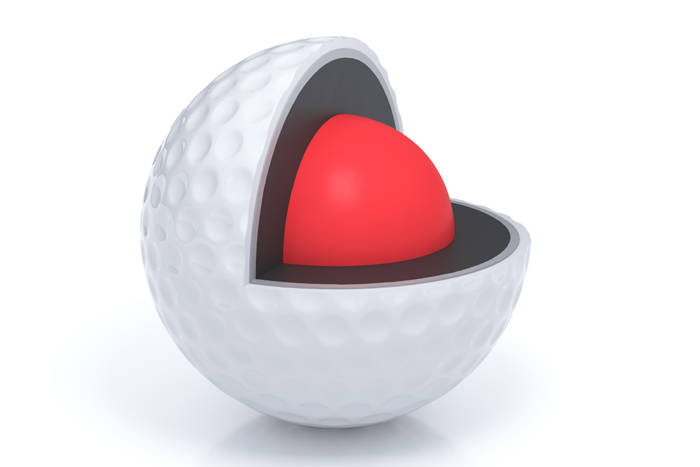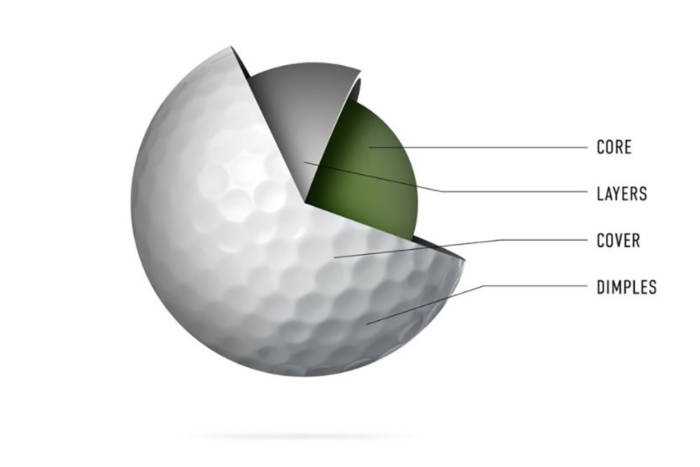What’s Inside A Golf Ball?
In any sport, it is important to understand the gear with which you are playing, and when it comes to golf, one of the most important items is the golf ball. But have you ever wondered what is inside a golf ball? Or what it is made out of?
The design is very important, as it is what ensures that the golf ball works properly when playing!
Ever since the humble beginnings of golf balls in the 14th century, when they were simple lopsided pieces of wood, the design has evolved and come a long way. In fact, golf balls nowadays look nothing like their origins!

(And that’s definitely for the better). Throughout history, there have been different designs, including golf balls that had liquid at the core. But the design used currently, is by far the best and most efficient.
But what is the current design? And going back to the initial question, what is inside the golf ball? Well we’ll answer these questions below, along with the reasoning behind the design.
The construction of a golf ball
The golf ball is one of the most important parts of golfing equipment, if not the outright most important of all. After all, the golf ball is what you use over and over, for every single shot, and it can seriously affect your game outcome!
Nowadays, golf balls are made from a range of different materials, using different methods, so there are a few options from which you can choose, to better suit your playing style. However, they all follow pretty much the same construction design, with the same similar parts.
This is also where quality comes in. Higher quality golf balls will usually have a more complex construction with more layers to the ball. Each layer is built with precision in mind and offers something different to the performance of the golf ball. As you can imagine, these higher-quality golf balls are much more expensive and perform far better than an entry-level one!
We’ve done a more detailed post here on the different types of golf balls which goes into detail on the differences from 2 piece construction golf balls up to 5 piece construction golf balls, if that’s something you’re interested in.
Whilst golf balls can vary vastly in their construction, there are also a few rules when it comes to the construction of golf balls, especially within official competitions, meaning they are all similar in a couple of ways.
According to the USGA regulations, a golf ball has to weigh 1.62 ounces or less. The ball’s diameter can’t be any less than 1.68 inches, but there is no maximum size. Other than that, players can choose their own types of golf balls, with a design that is advantageous to their playing technique and style.
What is inside a golf ball?
Let’s get to the important question: what is inside a golf ball? Is it empty? Is it solid all the way through?
The answer is neither of those. Inside a golf ball, there is a core, with layers, and then the outer cover. Finished off by the iconic dimples that characterize a golf ball, of course.
To help you visualize this better, here is a photo:

So basically, the parts that we see of the golf ball are the surface dimples and the outer cover. And within the golf ball, we find one or several layers, and within them, the core of the ball.
As above, it’s important to remember that the number of layers and size of core will depend on the brand of golf ball and the construction type. Higher performance golf balls wil typically have more layers, whilst cheaper “distance” golf balls will have less.
Explanation of the different parts of a golf ball
Now that you know what is inside a golf ball, and what the different parts are, you might be wondering the reason behind them, and why the ball is designed in this way. So let’s expand on the different parts of the golf ball:
Core
The core of the golf ball is a bit like the engine, as it is what mostly influences the speed, the distance it goes, and the spin, in both the long and short game.
The reason why the core is like an engine is that the force that is used to hit the ball gets directly transferred into the core (which is an injection-molded rubber). The force is stored there and then released, launching the ball forward.
If you’ve ver seen a video of golf ball compression in slow motion, you’ll understand how this works, where the club forces the golf ball to compress into an oval shape before launching off the tee. Well, it’s the core of the golf ball that’s driving this.
The way in which the core is constructed affects the way in which the force is directed, determining the performance.
The compression of a golf ball is basically a reflection of how hard or soft the ball compresses against the club head when hit, so a softer ball will compress more, and a harder ball will compress less.
This is why it is important for golfers to think about the construction and material of the core! For example, golfers with a fast swing usually prefer a harder ball. However, it completely depends on your technique, your preference, and your experience.
Layers
If the golf ball is multi-layered (which more common the higher up the golf ball market you go), then it will have a layer or several layers in between the core and the cover. These help increase the spin of the ball and allow for the player to have more control, especially in the short game.
The number of layers affects the way in which the force of the hit reaches the core, and is then redirected, so this is also something that golfers must think about when choosing the right ball for them!
Cover
The cover of the golf ball is what we see and feel, and it is what most impacts the ball’s spin when hit by the head of the golf club, especially in the short game.
The type of cover used (as there are different materials), highly affects the performance of the ball, as it is the first part to come into contact with the golf club. Generally the cover of your golf ball will be made of Surlyn or Urethane.
Surlyn is extremely durable and is favoured for distance golf balls, which typically produce less spin. Urethane on the other hand, is slightly less durable and softer which offers a softer feel for golfers. Urethane covers are associated with the higher end of the market and will offer higher spin rates, particularly around the greens.
This is why golfers will spend quite some time testing out different golf balls until they find the type that is right for their technique and playing style.
Dimples
The dimples are the pattern over the cover, which gives the golf ball its iconic appearance and feel. The reason behind them is to make the ball more aerodynamic, decreasing the drag of the ball, and therefore increasing the distance, speed, and lift.
There are different dimple patterns and shapes depending which golf ball brand you use. There’s no right or wrong answer, but one thing is for certain – the golf ball wouldn’t fly correctly without them.
If you’re interested in more detail why golf balls have dimples, check out our post here.